Food and Drink Tourism: Destination Choices and Triple Bottom Line
VerifiedAdded on 2022/09/30
|12
|4122
|285
Report
AI Summary
This report provides a detailed analysis of food and drink tourism, exploring various classifications of tourists such as gastronomy, culinary, heritage, foodways, cultural, and gourmet tourists. It examines how food and drink significantly influence destination choices, highlighting the increasing importance of unique culinary experiences and the role of food in enhancing a destination's appeal. The report also delves into the measurement of the "Triple Bottom Line" (people, planet, and profit) to gauge success, failure, and sustainability within the tourism industry, emphasizing the importance of corporate social responsibility and the impact of food festivals. The report concludes by underscoring the need for businesses to adapt to evolving consumer preferences and the crucial role of food and drink in achieving long-term sustainability.
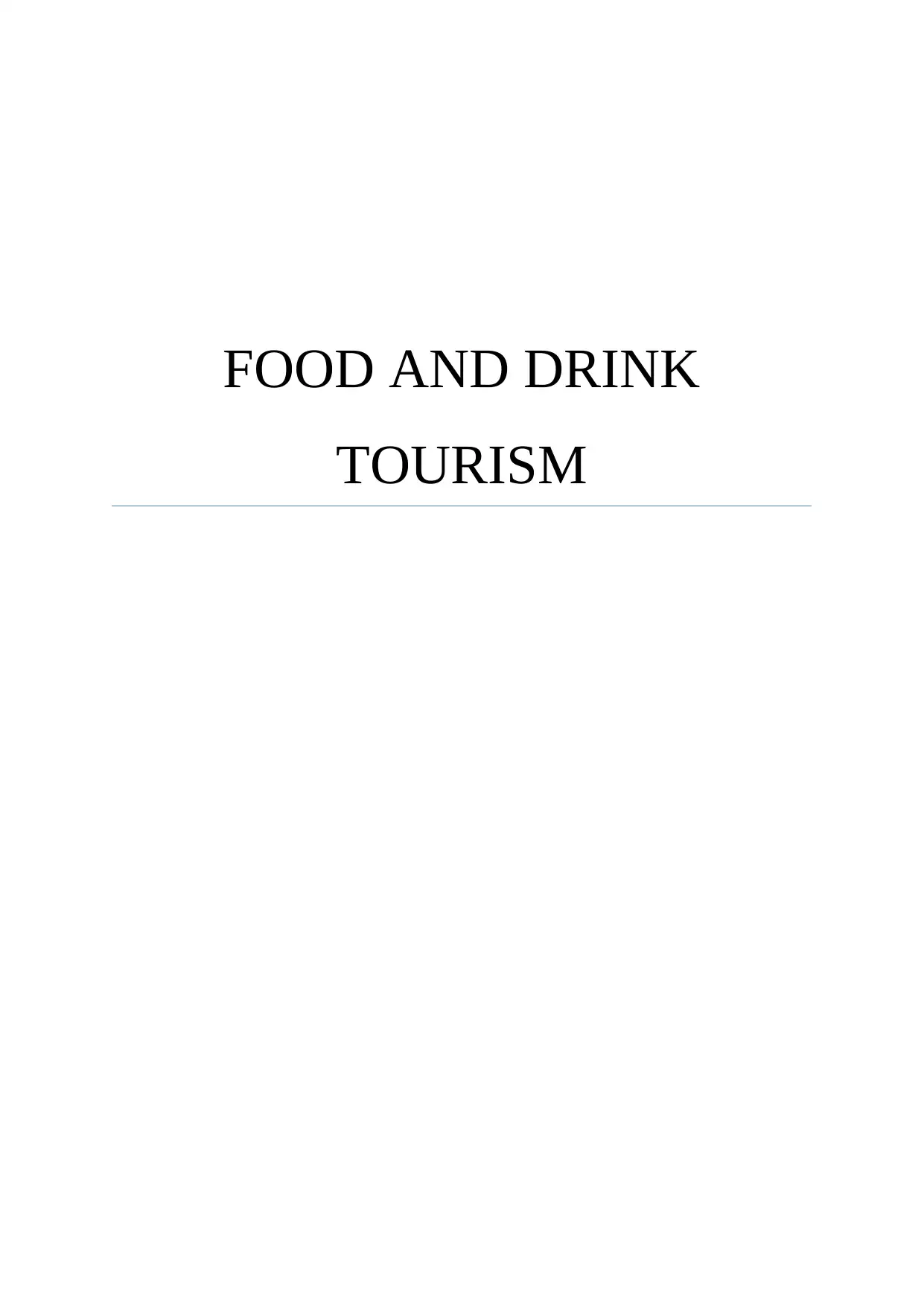
FOOD AND DRINK
TOURISM
TOURISM
Paraphrase This Document
Need a fresh take? Get an instant paraphrase of this document with our AI Paraphraser

1
Contents
INTRODUCTION.................................................................................................................................1
Classification of food and drink tourists................................................................................................1
Ways in which food and tourism acts as an important factor is making destination choices.................2
Measurement of “Triple bottom line” in gauging success, failure and sustainability.............................4
Food festival contribute to Triple Bottom line.......................................................................................5
Conclusion.............................................................................................................................................6
REFERENCES......................................................................................................................................7
Contents
INTRODUCTION.................................................................................................................................1
Classification of food and drink tourists................................................................................................1
Ways in which food and tourism acts as an important factor is making destination choices.................2
Measurement of “Triple bottom line” in gauging success, failure and sustainability.............................4
Food festival contribute to Triple Bottom line.......................................................................................5
Conclusion.............................................................................................................................................6
REFERENCES......................................................................................................................................7
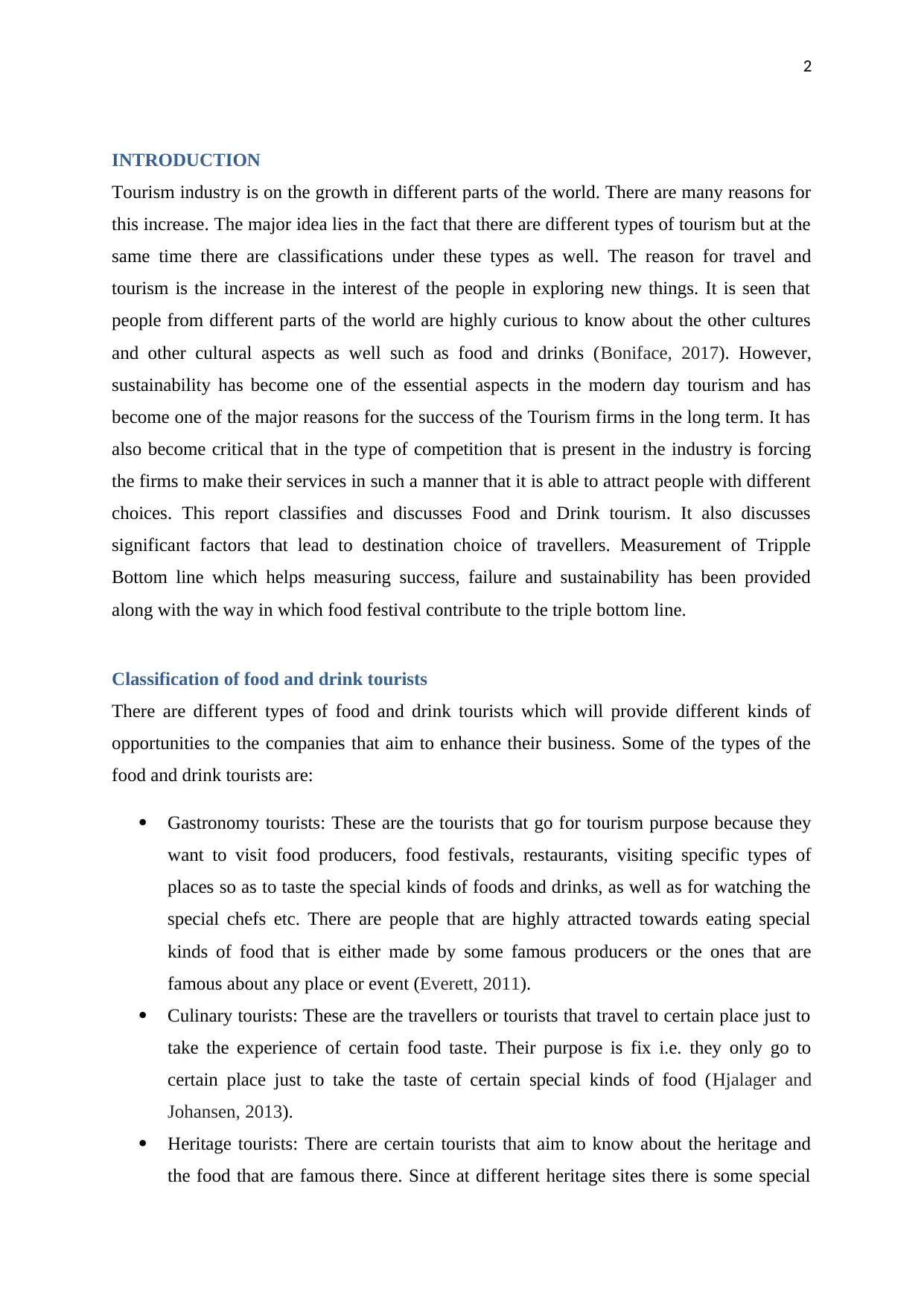
2
INTRODUCTION
Tourism industry is on the growth in different parts of the world. There are many reasons for
this increase. The major idea lies in the fact that there are different types of tourism but at the
same time there are classifications under these types as well. The reason for travel and
tourism is the increase in the interest of the people in exploring new things. It is seen that
people from different parts of the world are highly curious to know about the other cultures
and other cultural aspects as well such as food and drinks (Boniface, 2017). However,
sustainability has become one of the essential aspects in the modern day tourism and has
become one of the major reasons for the success of the Tourism firms in the long term. It has
also become critical that in the type of competition that is present in the industry is forcing
the firms to make their services in such a manner that it is able to attract people with different
choices. This report classifies and discusses Food and Drink tourism. It also discusses
significant factors that lead to destination choice of travellers. Measurement of Tripple
Bottom line which helps measuring success, failure and sustainability has been provided
along with the way in which food festival contribute to the triple bottom line.
Classification of food and drink tourists
There are different types of food and drink tourists which will provide different kinds of
opportunities to the companies that aim to enhance their business. Some of the types of the
food and drink tourists are:
Gastronomy tourists: These are the tourists that go for tourism purpose because they
want to visit food producers, food festivals, restaurants, visiting specific types of
places so as to taste the special kinds of foods and drinks, as well as for watching the
special chefs etc. There are people that are highly attracted towards eating special
kinds of food that is either made by some famous producers or the ones that are
famous about any place or event (Everett, 2011).
Culinary tourists: These are the travellers or tourists that travel to certain place just to
take the experience of certain food taste. Their purpose is fix i.e. they only go to
certain place just to take the taste of certain special kinds of food (Hjalager and
Johansen, 2013).
Heritage tourists: There are certain tourists that aim to know about the heritage and
the food that are famous there. Since at different heritage sites there is some special
INTRODUCTION
Tourism industry is on the growth in different parts of the world. There are many reasons for
this increase. The major idea lies in the fact that there are different types of tourism but at the
same time there are classifications under these types as well. The reason for travel and
tourism is the increase in the interest of the people in exploring new things. It is seen that
people from different parts of the world are highly curious to know about the other cultures
and other cultural aspects as well such as food and drinks (Boniface, 2017). However,
sustainability has become one of the essential aspects in the modern day tourism and has
become one of the major reasons for the success of the Tourism firms in the long term. It has
also become critical that in the type of competition that is present in the industry is forcing
the firms to make their services in such a manner that it is able to attract people with different
choices. This report classifies and discusses Food and Drink tourism. It also discusses
significant factors that lead to destination choice of travellers. Measurement of Tripple
Bottom line which helps measuring success, failure and sustainability has been provided
along with the way in which food festival contribute to the triple bottom line.
Classification of food and drink tourists
There are different types of food and drink tourists which will provide different kinds of
opportunities to the companies that aim to enhance their business. Some of the types of the
food and drink tourists are:
Gastronomy tourists: These are the tourists that go for tourism purpose because they
want to visit food producers, food festivals, restaurants, visiting specific types of
places so as to taste the special kinds of foods and drinks, as well as for watching the
special chefs etc. There are people that are highly attracted towards eating special
kinds of food that is either made by some famous producers or the ones that are
famous about any place or event (Everett, 2011).
Culinary tourists: These are the travellers or tourists that travel to certain place just to
take the experience of certain food taste. Their purpose is fix i.e. they only go to
certain place just to take the taste of certain special kinds of food (Hjalager and
Johansen, 2013).
Heritage tourists: There are certain tourists that aim to know about the heritage and
the food that are famous there. Since at different heritage sites there is some special
⊘ This is a preview!⊘
Do you want full access?
Subscribe today to unlock all pages.

Trusted by 1+ million students worldwide
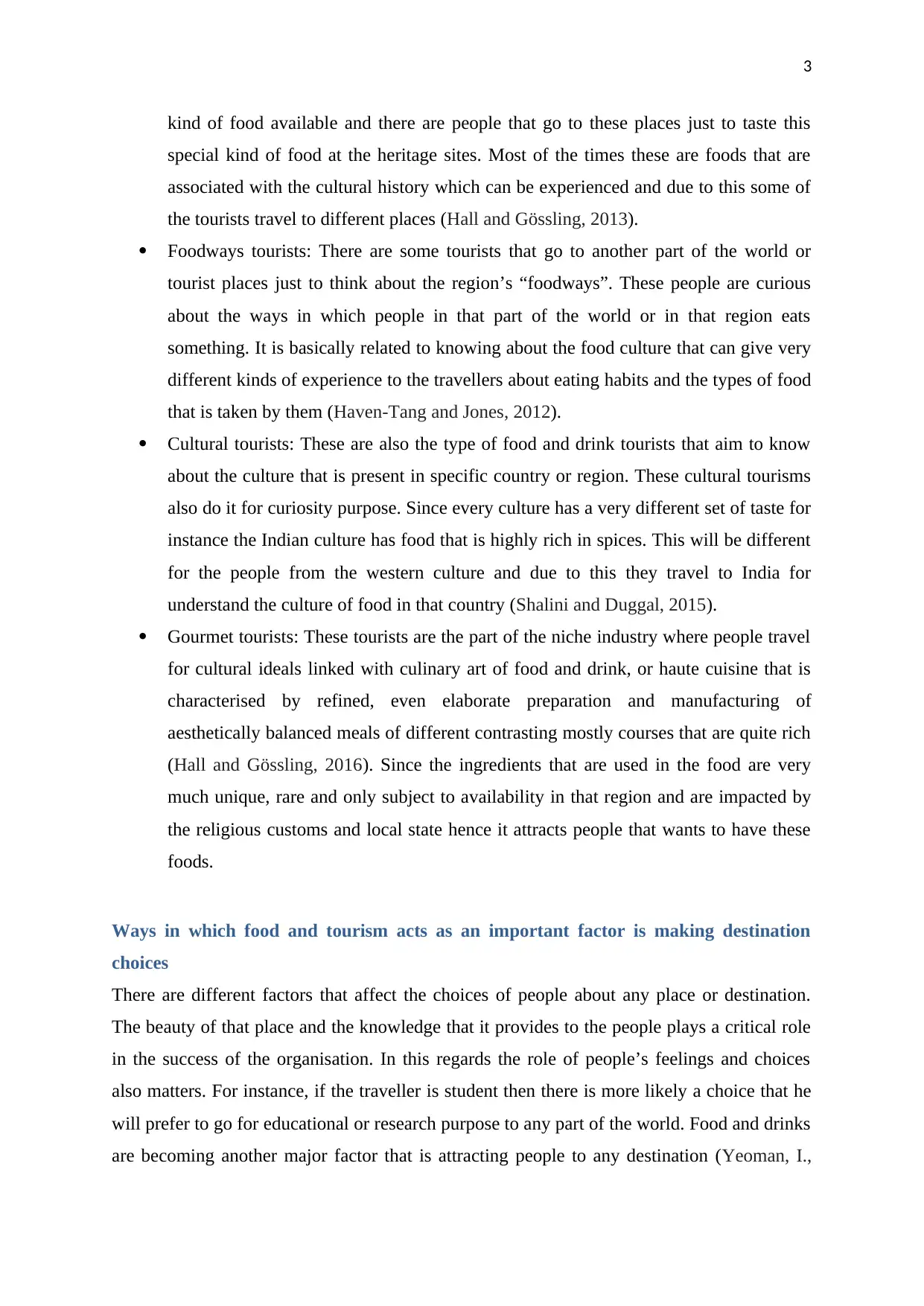
3
kind of food available and there are people that go to these places just to taste this
special kind of food at the heritage sites. Most of the times these are foods that are
associated with the cultural history which can be experienced and due to this some of
the tourists travel to different places (Hall and Gössling, 2013).
Foodways tourists: There are some tourists that go to another part of the world or
tourist places just to think about the region’s “foodways”. These people are curious
about the ways in which people in that part of the world or in that region eats
something. It is basically related to knowing about the food culture that can give very
different kinds of experience to the travellers about eating habits and the types of food
that is taken by them (Haven‐Tang and Jones, 2012).
Cultural tourists: These are also the type of food and drink tourists that aim to know
about the culture that is present in specific country or region. These cultural tourisms
also do it for curiosity purpose. Since every culture has a very different set of taste for
instance the Indian culture has food that is highly rich in spices. This will be different
for the people from the western culture and due to this they travel to India for
understand the culture of food in that country (Shalini and Duggal, 2015).
Gourmet tourists: These tourists are the part of the niche industry where people travel
for cultural ideals linked with culinary art of food and drink, or haute cuisine that is
characterised by refined, even elaborate preparation and manufacturing of
aesthetically balanced meals of different contrasting mostly courses that are quite rich
(Hall and Gössling, 2016). Since the ingredients that are used in the food are very
much unique, rare and only subject to availability in that region and are impacted by
the religious customs and local state hence it attracts people that wants to have these
foods.
Ways in which food and tourism acts as an important factor is making destination
choices
There are different factors that affect the choices of people about any place or destination.
The beauty of that place and the knowledge that it provides to the people plays a critical role
in the success of the organisation. In this regards the role of people’s feelings and choices
also matters. For instance, if the traveller is student then there is more likely a choice that he
will prefer to go for educational or research purpose to any part of the world. Food and drinks
are becoming another major factor that is attracting people to any destination (Yeoman, I.,
kind of food available and there are people that go to these places just to taste this
special kind of food at the heritage sites. Most of the times these are foods that are
associated with the cultural history which can be experienced and due to this some of
the tourists travel to different places (Hall and Gössling, 2013).
Foodways tourists: There are some tourists that go to another part of the world or
tourist places just to think about the region’s “foodways”. These people are curious
about the ways in which people in that part of the world or in that region eats
something. It is basically related to knowing about the food culture that can give very
different kinds of experience to the travellers about eating habits and the types of food
that is taken by them (Haven‐Tang and Jones, 2012).
Cultural tourists: These are also the type of food and drink tourists that aim to know
about the culture that is present in specific country or region. These cultural tourisms
also do it for curiosity purpose. Since every culture has a very different set of taste for
instance the Indian culture has food that is highly rich in spices. This will be different
for the people from the western culture and due to this they travel to India for
understand the culture of food in that country (Shalini and Duggal, 2015).
Gourmet tourists: These tourists are the part of the niche industry where people travel
for cultural ideals linked with culinary art of food and drink, or haute cuisine that is
characterised by refined, even elaborate preparation and manufacturing of
aesthetically balanced meals of different contrasting mostly courses that are quite rich
(Hall and Gössling, 2016). Since the ingredients that are used in the food are very
much unique, rare and only subject to availability in that region and are impacted by
the religious customs and local state hence it attracts people that wants to have these
foods.
Ways in which food and tourism acts as an important factor is making destination
choices
There are different factors that affect the choices of people about any place or destination.
The beauty of that place and the knowledge that it provides to the people plays a critical role
in the success of the organisation. In this regards the role of people’s feelings and choices
also matters. For instance, if the traveller is student then there is more likely a choice that he
will prefer to go for educational or research purpose to any part of the world. Food and drinks
are becoming another major factor that is attracting people to any destination (Yeoman, I.,
Paraphrase This Document
Need a fresh take? Get an instant paraphrase of this document with our AI Paraphraser
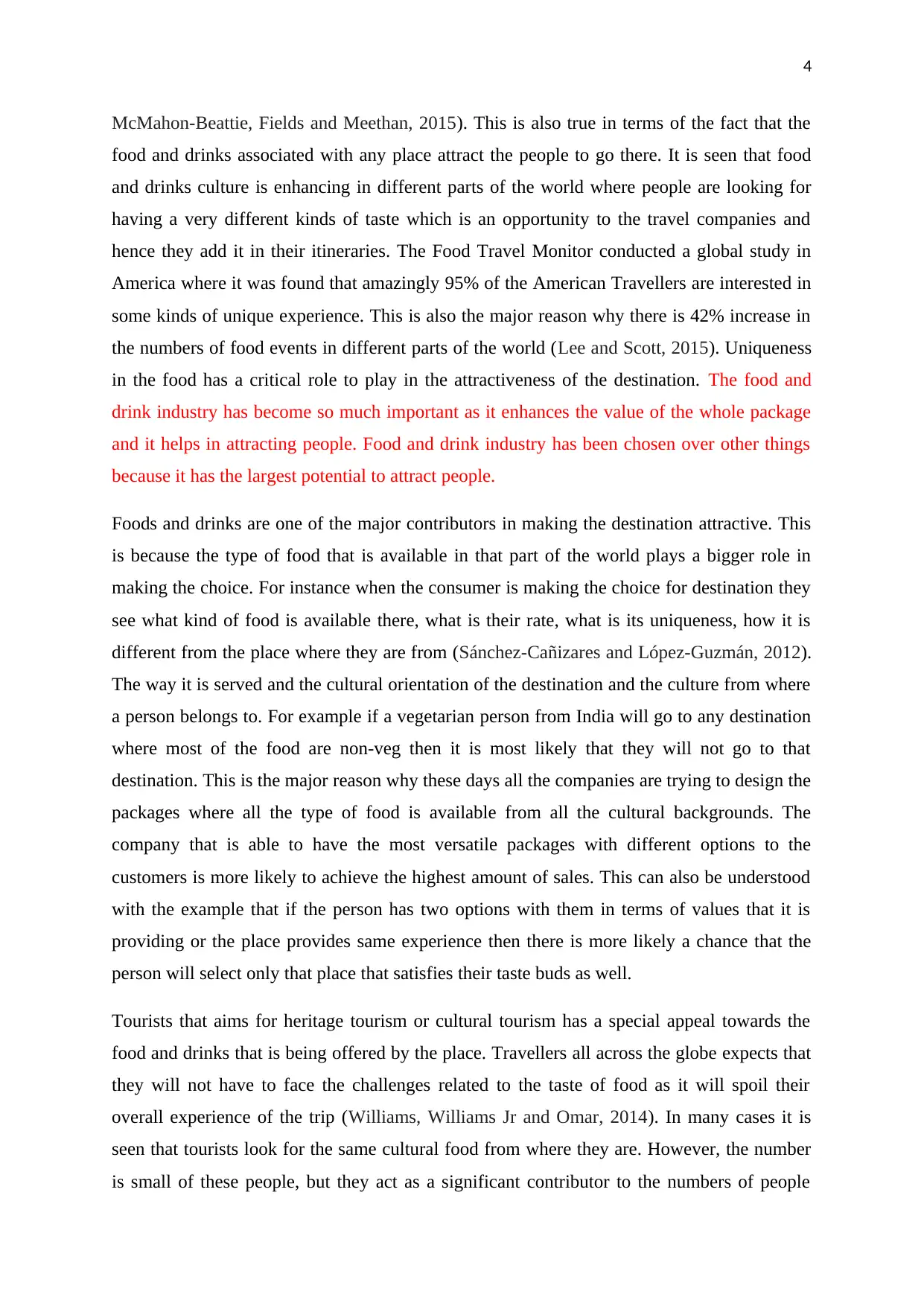
4
McMahon-Beattie, Fields and Meethan, 2015). This is also true in terms of the fact that the
food and drinks associated with any place attract the people to go there. It is seen that food
and drinks culture is enhancing in different parts of the world where people are looking for
having a very different kinds of taste which is an opportunity to the travel companies and
hence they add it in their itineraries. The Food Travel Monitor conducted a global study in
America where it was found that amazingly 95% of the American Travellers are interested in
some kinds of unique experience. This is also the major reason why there is 42% increase in
the numbers of food events in different parts of the world (Lee and Scott, 2015). Uniqueness
in the food has a critical role to play in the attractiveness of the destination. The food and
drink industry has become so much important as it enhances the value of the whole package
and it helps in attracting people. Food and drink industry has been chosen over other things
because it has the largest potential to attract people.
Foods and drinks are one of the major contributors in making the destination attractive. This
is because the type of food that is available in that part of the world plays a bigger role in
making the choice. For instance when the consumer is making the choice for destination they
see what kind of food is available there, what is their rate, what is its uniqueness, how it is
different from the place where they are from (Sánchez-Cañizares and López-Guzmán, 2012).
The way it is served and the cultural orientation of the destination and the culture from where
a person belongs to. For example if a vegetarian person from India will go to any destination
where most of the food are non-veg then it is most likely that they will not go to that
destination. This is the major reason why these days all the companies are trying to design the
packages where all the type of food is available from all the cultural backgrounds. The
company that is able to have the most versatile packages with different options to the
customers is more likely to achieve the highest amount of sales. This can also be understood
with the example that if the person has two options with them in terms of values that it is
providing or the place provides same experience then there is more likely a chance that the
person will select only that place that satisfies their taste buds as well.
Tourists that aims for heritage tourism or cultural tourism has a special appeal towards the
food and drinks that is being offered by the place. Travellers all across the globe expects that
they will not have to face the challenges related to the taste of food as it will spoil their
overall experience of the trip (Williams, Williams Jr and Omar, 2014). In many cases it is
seen that tourists look for the same cultural food from where they are. However, the number
is small of these people, but they act as a significant contributor to the numbers of people
McMahon-Beattie, Fields and Meethan, 2015). This is also true in terms of the fact that the
food and drinks associated with any place attract the people to go there. It is seen that food
and drinks culture is enhancing in different parts of the world where people are looking for
having a very different kinds of taste which is an opportunity to the travel companies and
hence they add it in their itineraries. The Food Travel Monitor conducted a global study in
America where it was found that amazingly 95% of the American Travellers are interested in
some kinds of unique experience. This is also the major reason why there is 42% increase in
the numbers of food events in different parts of the world (Lee and Scott, 2015). Uniqueness
in the food has a critical role to play in the attractiveness of the destination. The food and
drink industry has become so much important as it enhances the value of the whole package
and it helps in attracting people. Food and drink industry has been chosen over other things
because it has the largest potential to attract people.
Foods and drinks are one of the major contributors in making the destination attractive. This
is because the type of food that is available in that part of the world plays a bigger role in
making the choice. For instance when the consumer is making the choice for destination they
see what kind of food is available there, what is their rate, what is its uniqueness, how it is
different from the place where they are from (Sánchez-Cañizares and López-Guzmán, 2012).
The way it is served and the cultural orientation of the destination and the culture from where
a person belongs to. For example if a vegetarian person from India will go to any destination
where most of the food are non-veg then it is most likely that they will not go to that
destination. This is the major reason why these days all the companies are trying to design the
packages where all the type of food is available from all the cultural backgrounds. The
company that is able to have the most versatile packages with different options to the
customers is more likely to achieve the highest amount of sales. This can also be understood
with the example that if the person has two options with them in terms of values that it is
providing or the place provides same experience then there is more likely a chance that the
person will select only that place that satisfies their taste buds as well.
Tourists that aims for heritage tourism or cultural tourism has a special appeal towards the
food and drinks that is being offered by the place. Travellers all across the globe expects that
they will not have to face the challenges related to the taste of food as it will spoil their
overall experience of the trip (Williams, Williams Jr and Omar, 2014). In many cases it is
seen that tourists look for the same cultural food from where they are. However, the number
is small of these people, but they act as a significant contributor to the numbers of people
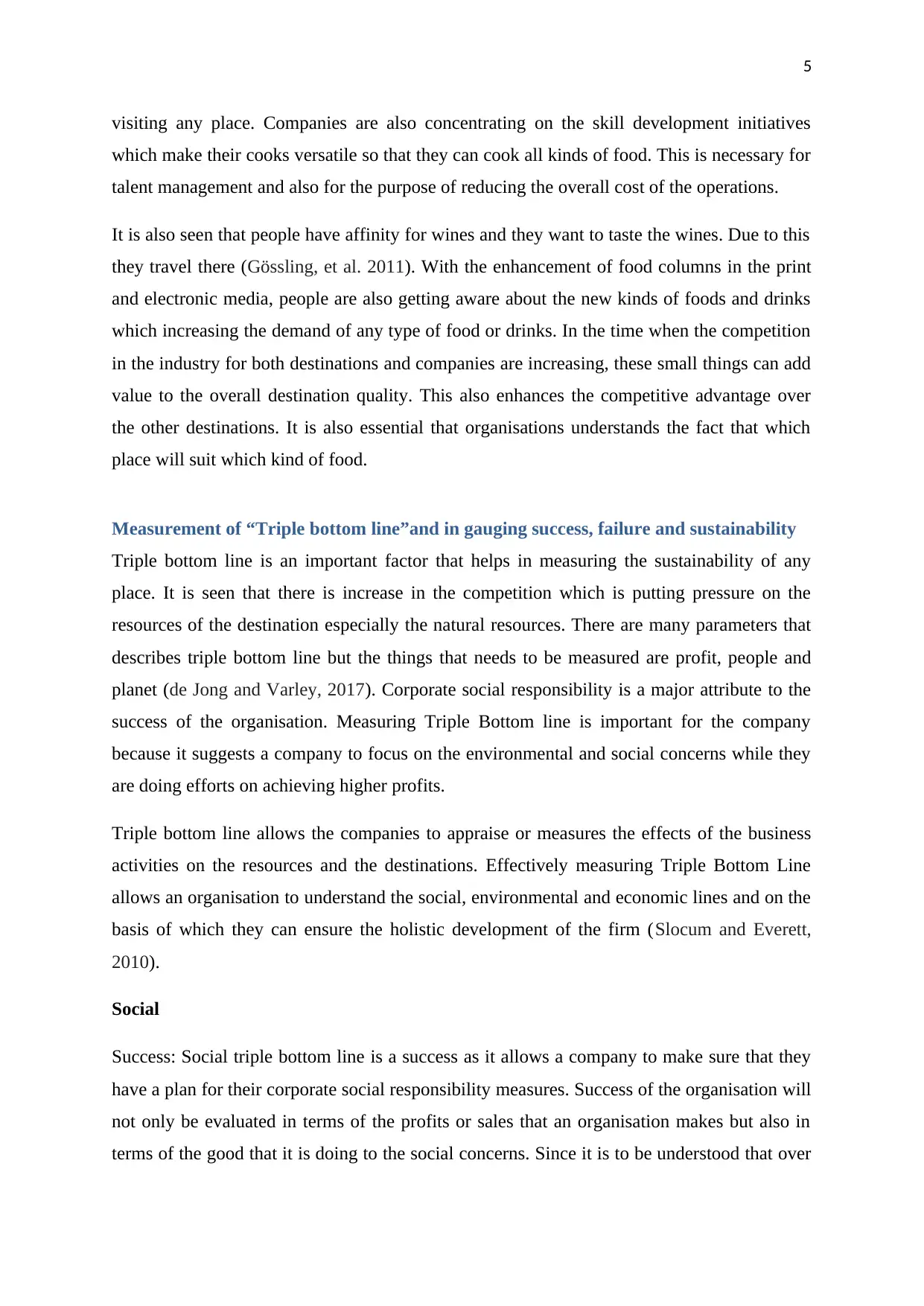
5
visiting any place. Companies are also concentrating on the skill development initiatives
which make their cooks versatile so that they can cook all kinds of food. This is necessary for
talent management and also for the purpose of reducing the overall cost of the operations.
It is also seen that people have affinity for wines and they want to taste the wines. Due to this
they travel there (Gössling, et al. 2011). With the enhancement of food columns in the print
and electronic media, people are also getting aware about the new kinds of foods and drinks
which increasing the demand of any type of food or drinks. In the time when the competition
in the industry for both destinations and companies are increasing, these small things can add
value to the overall destination quality. This also enhances the competitive advantage over
the other destinations. It is also essential that organisations understands the fact that which
place will suit which kind of food.
Measurement of “Triple bottom line”and in gauging success, failure and sustainability
Triple bottom line is an important factor that helps in measuring the sustainability of any
place. It is seen that there is increase in the competition which is putting pressure on the
resources of the destination especially the natural resources. There are many parameters that
describes triple bottom line but the things that needs to be measured are profit, people and
planet (de Jong and Varley, 2017). Corporate social responsibility is a major attribute to the
success of the organisation. Measuring Triple Bottom line is important for the company
because it suggests a company to focus on the environmental and social concerns while they
are doing efforts on achieving higher profits.
Triple bottom line allows the companies to appraise or measures the effects of the business
activities on the resources and the destinations. Effectively measuring Triple Bottom Line
allows an organisation to understand the social, environmental and economic lines and on the
basis of which they can ensure the holistic development of the firm (Slocum and Everett,
2010).
Social
Success: Social triple bottom line is a success as it allows a company to make sure that they
have a plan for their corporate social responsibility measures. Success of the organisation will
not only be evaluated in terms of the profits or sales that an organisation makes but also in
terms of the good that it is doing to the social concerns. Since it is to be understood that over
visiting any place. Companies are also concentrating on the skill development initiatives
which make their cooks versatile so that they can cook all kinds of food. This is necessary for
talent management and also for the purpose of reducing the overall cost of the operations.
It is also seen that people have affinity for wines and they want to taste the wines. Due to this
they travel there (Gössling, et al. 2011). With the enhancement of food columns in the print
and electronic media, people are also getting aware about the new kinds of foods and drinks
which increasing the demand of any type of food or drinks. In the time when the competition
in the industry for both destinations and companies are increasing, these small things can add
value to the overall destination quality. This also enhances the competitive advantage over
the other destinations. It is also essential that organisations understands the fact that which
place will suit which kind of food.
Measurement of “Triple bottom line”and in gauging success, failure and sustainability
Triple bottom line is an important factor that helps in measuring the sustainability of any
place. It is seen that there is increase in the competition which is putting pressure on the
resources of the destination especially the natural resources. There are many parameters that
describes triple bottom line but the things that needs to be measured are profit, people and
planet (de Jong and Varley, 2017). Corporate social responsibility is a major attribute to the
success of the organisation. Measuring Triple Bottom line is important for the company
because it suggests a company to focus on the environmental and social concerns while they
are doing efforts on achieving higher profits.
Triple bottom line allows the companies to appraise or measures the effects of the business
activities on the resources and the destinations. Effectively measuring Triple Bottom Line
allows an organisation to understand the social, environmental and economic lines and on the
basis of which they can ensure the holistic development of the firm (Slocum and Everett,
2010).
Social
Success: Social triple bottom line is a success as it allows a company to make sure that they
have a plan for their corporate social responsibility measures. Success of the organisation will
not only be evaluated in terms of the profits or sales that an organisation makes but also in
terms of the good that it is doing to the social concerns. Since it is to be understood that over
⊘ This is a preview!⊘
Do you want full access?
Subscribe today to unlock all pages.

Trusted by 1+ million students worldwide
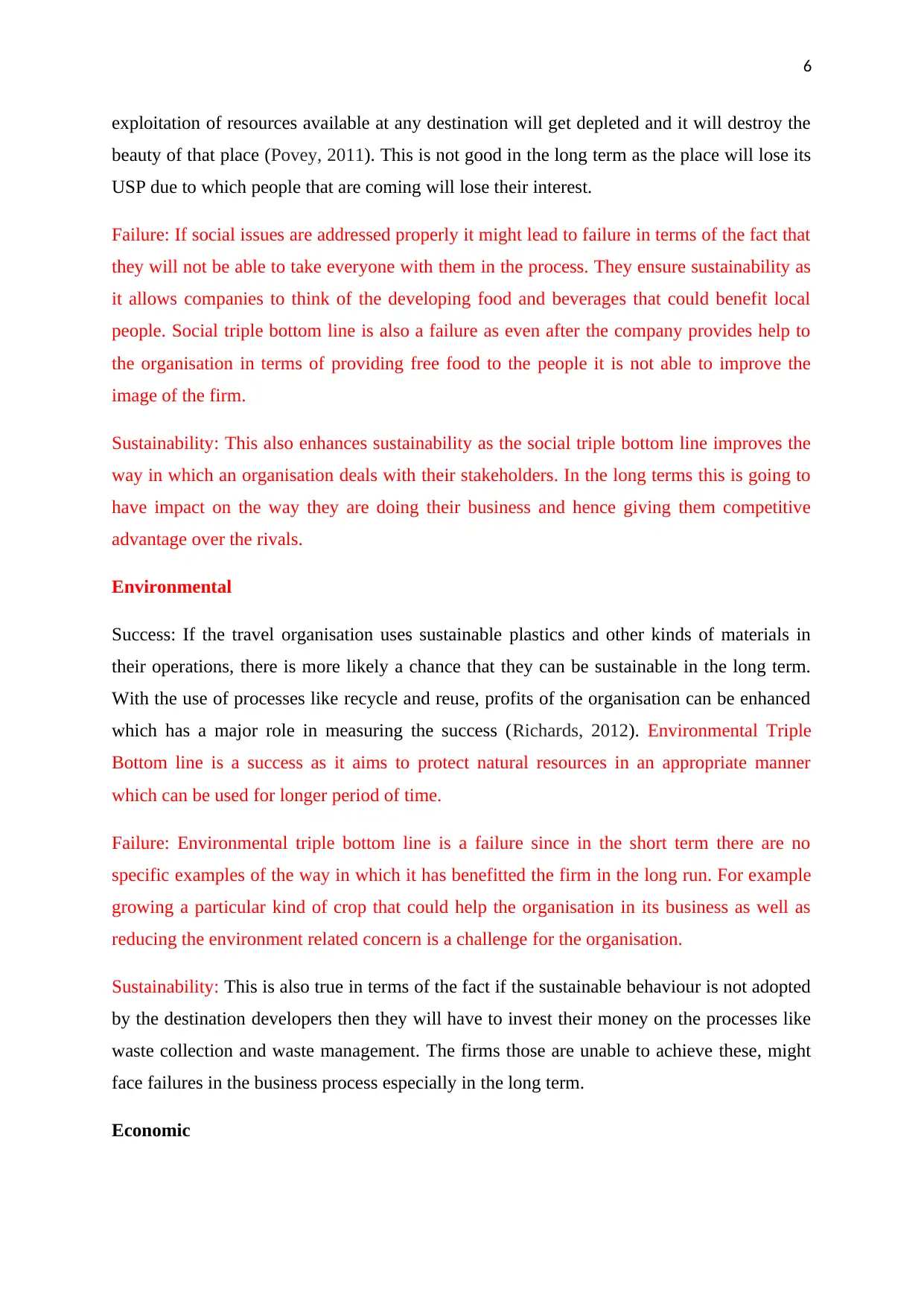
6
exploitation of resources available at any destination will get depleted and it will destroy the
beauty of that place (Povey, 2011). This is not good in the long term as the place will lose its
USP due to which people that are coming will lose their interest.
Failure: If social issues are addressed properly it might lead to failure in terms of the fact that
they will not be able to take everyone with them in the process. They ensure sustainability as
it allows companies to think of the developing food and beverages that could benefit local
people. Social triple bottom line is also a failure as even after the company provides help to
the organisation in terms of providing free food to the people it is not able to improve the
image of the firm.
Sustainability: This also enhances sustainability as the social triple bottom line improves the
way in which an organisation deals with their stakeholders. In the long terms this is going to
have impact on the way they are doing their business and hence giving them competitive
advantage over the rivals.
Environmental
Success: If the travel organisation uses sustainable plastics and other kinds of materials in
their operations, there is more likely a chance that they can be sustainable in the long term.
With the use of processes like recycle and reuse, profits of the organisation can be enhanced
which has a major role in measuring the success (Richards, 2012). Environmental Triple
Bottom line is a success as it aims to protect natural resources in an appropriate manner
which can be used for longer period of time.
Failure: Environmental triple bottom line is a failure since in the short term there are no
specific examples of the way in which it has benefitted the firm in the long run. For example
growing a particular kind of crop that could help the organisation in its business as well as
reducing the environment related concern is a challenge for the organisation.
Sustainability: This is also true in terms of the fact if the sustainable behaviour is not adopted
by the destination developers then they will have to invest their money on the processes like
waste collection and waste management. The firms those are unable to achieve these, might
face failures in the business process especially in the long term.
Economic
exploitation of resources available at any destination will get depleted and it will destroy the
beauty of that place (Povey, 2011). This is not good in the long term as the place will lose its
USP due to which people that are coming will lose their interest.
Failure: If social issues are addressed properly it might lead to failure in terms of the fact that
they will not be able to take everyone with them in the process. They ensure sustainability as
it allows companies to think of the developing food and beverages that could benefit local
people. Social triple bottom line is also a failure as even after the company provides help to
the organisation in terms of providing free food to the people it is not able to improve the
image of the firm.
Sustainability: This also enhances sustainability as the social triple bottom line improves the
way in which an organisation deals with their stakeholders. In the long terms this is going to
have impact on the way they are doing their business and hence giving them competitive
advantage over the rivals.
Environmental
Success: If the travel organisation uses sustainable plastics and other kinds of materials in
their operations, there is more likely a chance that they can be sustainable in the long term.
With the use of processes like recycle and reuse, profits of the organisation can be enhanced
which has a major role in measuring the success (Richards, 2012). Environmental Triple
Bottom line is a success as it aims to protect natural resources in an appropriate manner
which can be used for longer period of time.
Failure: Environmental triple bottom line is a failure since in the short term there are no
specific examples of the way in which it has benefitted the firm in the long run. For example
growing a particular kind of crop that could help the organisation in its business as well as
reducing the environment related concern is a challenge for the organisation.
Sustainability: This is also true in terms of the fact if the sustainable behaviour is not adopted
by the destination developers then they will have to invest their money on the processes like
waste collection and waste management. The firms those are unable to achieve these, might
face failures in the business process especially in the long term.
Economic
Paraphrase This Document
Need a fresh take? Get an instant paraphrase of this document with our AI Paraphraser
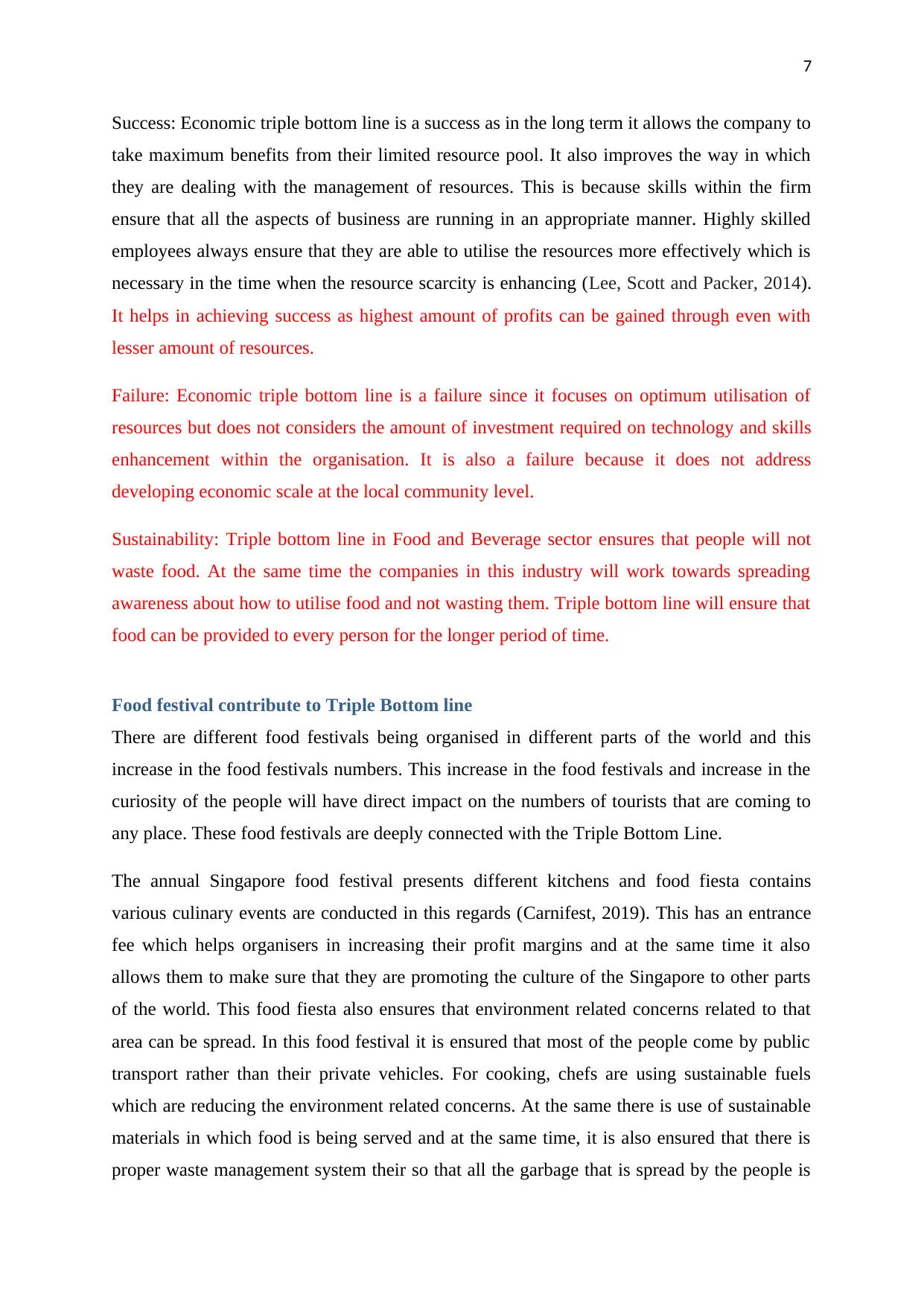
7
Success: Economic triple bottom line is a success as in the long term it allows the company to
take maximum benefits from their limited resource pool. It also improves the way in which
they are dealing with the management of resources. This is because skills within the firm
ensure that all the aspects of business are running in an appropriate manner. Highly skilled
employees always ensure that they are able to utilise the resources more effectively which is
necessary in the time when the resource scarcity is enhancing (Lee, Scott and Packer, 2014).
It helps in achieving success as highest amount of profits can be gained through even with
lesser amount of resources.
Failure: Economic triple bottom line is a failure since it focuses on optimum utilisation of
resources but does not considers the amount of investment required on technology and skills
enhancement within the organisation. It is also a failure because it does not address
developing economic scale at the local community level.
Sustainability: Triple bottom line in Food and Beverage sector ensures that people will not
waste food. At the same time the companies in this industry will work towards spreading
awareness about how to utilise food and not wasting them. Triple bottom line will ensure that
food can be provided to every person for the longer period of time.
Food festival contribute to Triple Bottom line
There are different food festivals being organised in different parts of the world and this
increase in the food festivals numbers. This increase in the food festivals and increase in the
curiosity of the people will have direct impact on the numbers of tourists that are coming to
any place. These food festivals are deeply connected with the Triple Bottom Line.
The annual Singapore food festival presents different kitchens and food fiesta contains
various culinary events are conducted in this regards (Carnifest, 2019). This has an entrance
fee which helps organisers in increasing their profit margins and at the same time it also
allows them to make sure that they are promoting the culture of the Singapore to other parts
of the world. This food fiesta also ensures that environment related concerns related to that
area can be spread. In this food festival it is ensured that most of the people come by public
transport rather than their private vehicles. For cooking, chefs are using sustainable fuels
which are reducing the environment related concerns. At the same there is use of sustainable
materials in which food is being served and at the same time, it is also ensured that there is
proper waste management system their so that all the garbage that is spread by the people is
Success: Economic triple bottom line is a success as in the long term it allows the company to
take maximum benefits from their limited resource pool. It also improves the way in which
they are dealing with the management of resources. This is because skills within the firm
ensure that all the aspects of business are running in an appropriate manner. Highly skilled
employees always ensure that they are able to utilise the resources more effectively which is
necessary in the time when the resource scarcity is enhancing (Lee, Scott and Packer, 2014).
It helps in achieving success as highest amount of profits can be gained through even with
lesser amount of resources.
Failure: Economic triple bottom line is a failure since it focuses on optimum utilisation of
resources but does not considers the amount of investment required on technology and skills
enhancement within the organisation. It is also a failure because it does not address
developing economic scale at the local community level.
Sustainability: Triple bottom line in Food and Beverage sector ensures that people will not
waste food. At the same time the companies in this industry will work towards spreading
awareness about how to utilise food and not wasting them. Triple bottom line will ensure that
food can be provided to every person for the longer period of time.
Food festival contribute to Triple Bottom line
There are different food festivals being organised in different parts of the world and this
increase in the food festivals numbers. This increase in the food festivals and increase in the
curiosity of the people will have direct impact on the numbers of tourists that are coming to
any place. These food festivals are deeply connected with the Triple Bottom Line.
The annual Singapore food festival presents different kitchens and food fiesta contains
various culinary events are conducted in this regards (Carnifest, 2019). This has an entrance
fee which helps organisers in increasing their profit margins and at the same time it also
allows them to make sure that they are promoting the culture of the Singapore to other parts
of the world. This food fiesta also ensures that environment related concerns related to that
area can be spread. In this food festival it is ensured that most of the people come by public
transport rather than their private vehicles. For cooking, chefs are using sustainable fuels
which are reducing the environment related concerns. At the same there is use of sustainable
materials in which food is being served and at the same time, it is also ensured that there is
proper waste management system their so that all the garbage that is spread by the people is
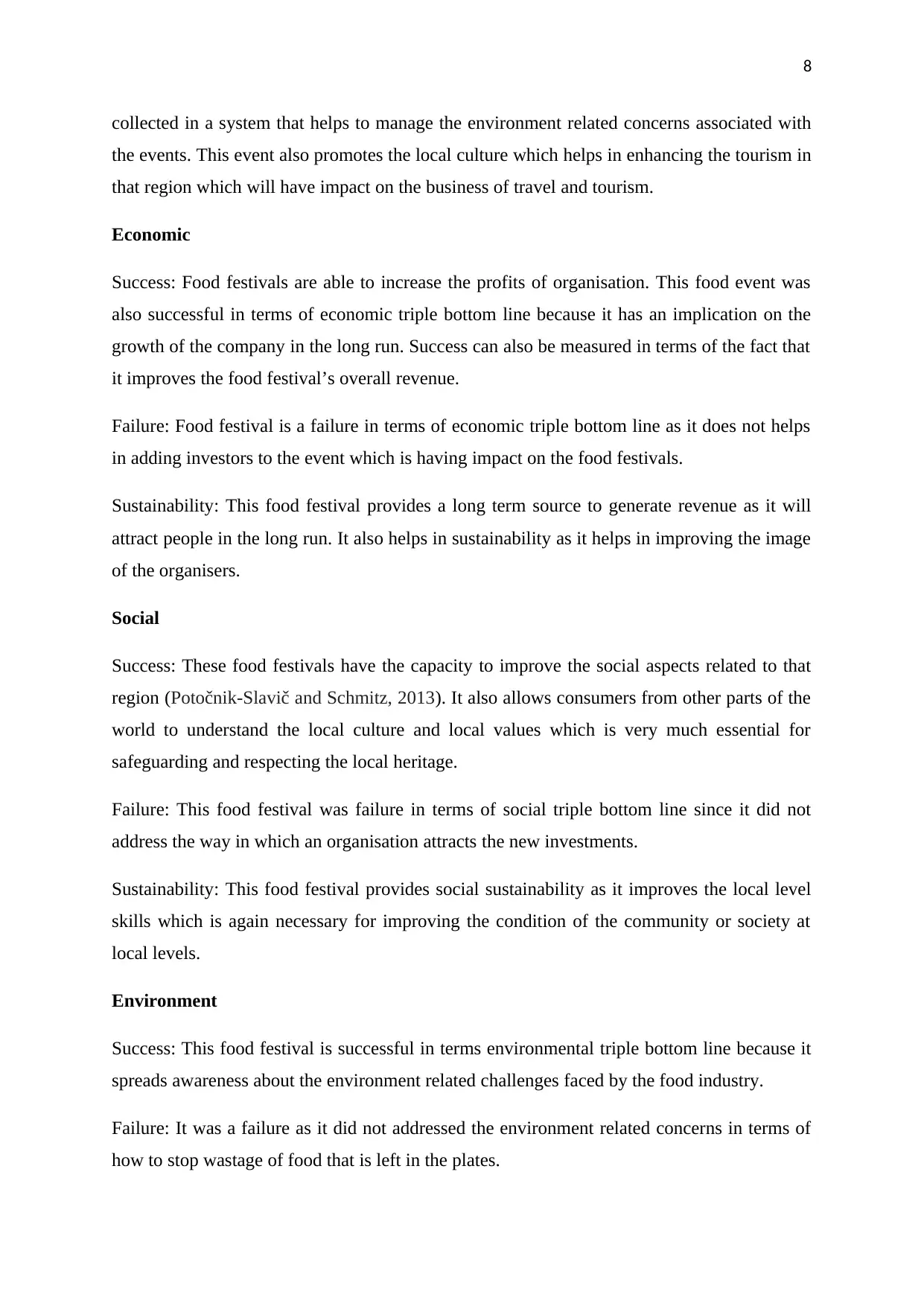
8
collected in a system that helps to manage the environment related concerns associated with
the events. This event also promotes the local culture which helps in enhancing the tourism in
that region which will have impact on the business of travel and tourism.
Economic
Success: Food festivals are able to increase the profits of organisation. This food event was
also successful in terms of economic triple bottom line because it has an implication on the
growth of the company in the long run. Success can also be measured in terms of the fact that
it improves the food festival’s overall revenue.
Failure: Food festival is a failure in terms of economic triple bottom line as it does not helps
in adding investors to the event which is having impact on the food festivals.
Sustainability: This food festival provides a long term source to generate revenue as it will
attract people in the long run. It also helps in sustainability as it helps in improving the image
of the organisers.
Social
Success: These food festivals have the capacity to improve the social aspects related to that
region (Potočnik-Slavič and Schmitz, 2013). It also allows consumers from other parts of the
world to understand the local culture and local values which is very much essential for
safeguarding and respecting the local heritage.
Failure: This food festival was failure in terms of social triple bottom line since it did not
address the way in which an organisation attracts the new investments.
Sustainability: This food festival provides social sustainability as it improves the local level
skills which is again necessary for improving the condition of the community or society at
local levels.
Environment
Success: This food festival is successful in terms environmental triple bottom line because it
spreads awareness about the environment related challenges faced by the food industry.
Failure: It was a failure as it did not addressed the environment related concerns in terms of
how to stop wastage of food that is left in the plates.
collected in a system that helps to manage the environment related concerns associated with
the events. This event also promotes the local culture which helps in enhancing the tourism in
that region which will have impact on the business of travel and tourism.
Economic
Success: Food festivals are able to increase the profits of organisation. This food event was
also successful in terms of economic triple bottom line because it has an implication on the
growth of the company in the long run. Success can also be measured in terms of the fact that
it improves the food festival’s overall revenue.
Failure: Food festival is a failure in terms of economic triple bottom line as it does not helps
in adding investors to the event which is having impact on the food festivals.
Sustainability: This food festival provides a long term source to generate revenue as it will
attract people in the long run. It also helps in sustainability as it helps in improving the image
of the organisers.
Social
Success: These food festivals have the capacity to improve the social aspects related to that
region (Potočnik-Slavič and Schmitz, 2013). It also allows consumers from other parts of the
world to understand the local culture and local values which is very much essential for
safeguarding and respecting the local heritage.
Failure: This food festival was failure in terms of social triple bottom line since it did not
address the way in which an organisation attracts the new investments.
Sustainability: This food festival provides social sustainability as it improves the local level
skills which is again necessary for improving the condition of the community or society at
local levels.
Environment
Success: This food festival is successful in terms environmental triple bottom line because it
spreads awareness about the environment related challenges faced by the food industry.
Failure: It was a failure as it did not addressed the environment related concerns in terms of
how to stop wastage of food that is left in the plates.
⊘ This is a preview!⊘
Do you want full access?
Subscribe today to unlock all pages.

Trusted by 1+ million students worldwide
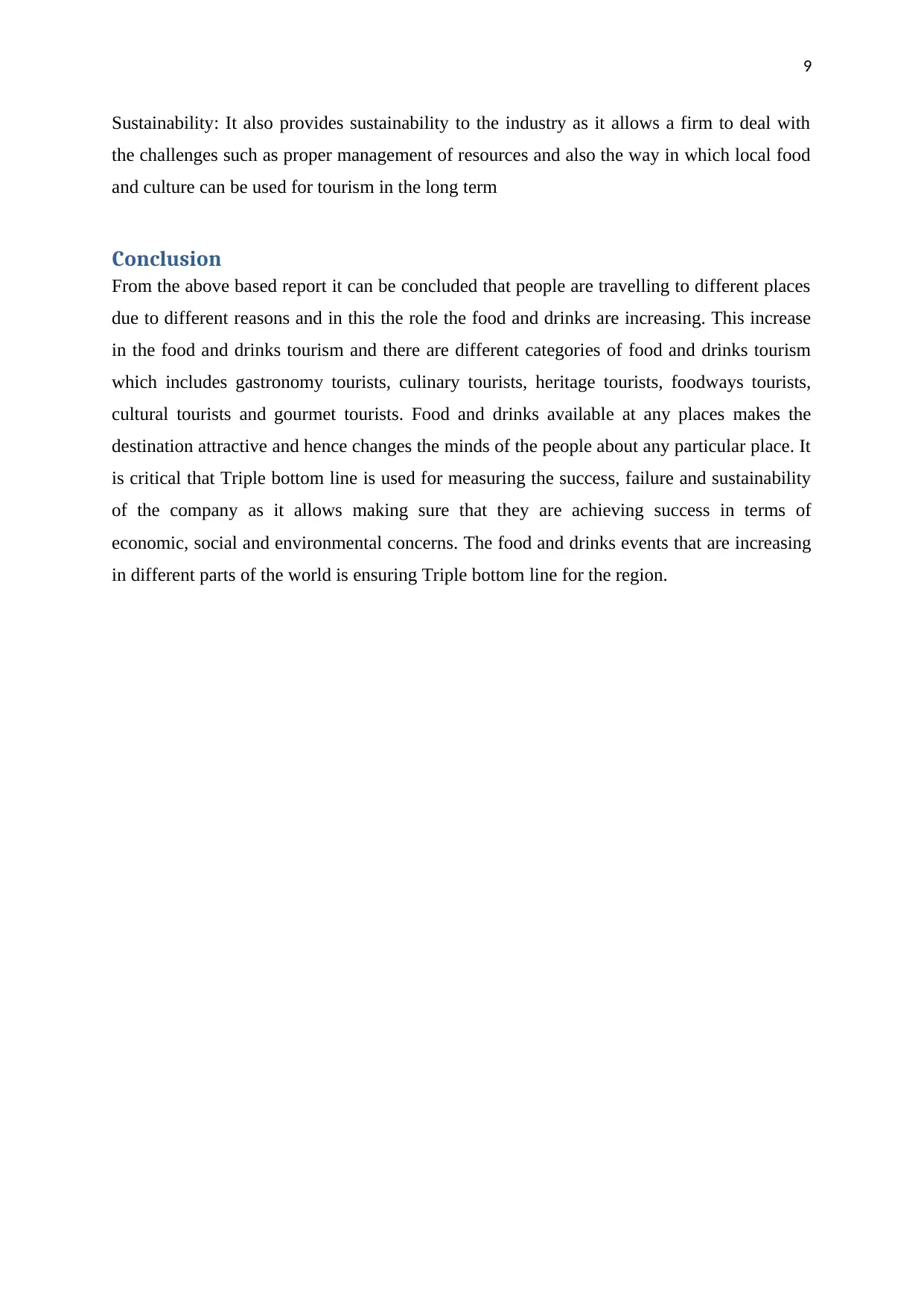
9
Sustainability: It also provides sustainability to the industry as it allows a firm to deal with
the challenges such as proper management of resources and also the way in which local food
and culture can be used for tourism in the long term
Conclusion
From the above based report it can be concluded that people are travelling to different places
due to different reasons and in this the role the food and drinks are increasing. This increase
in the food and drinks tourism and there are different categories of food and drinks tourism
which includes gastronomy tourists, culinary tourists, heritage tourists, foodways tourists,
cultural tourists and gourmet tourists. Food and drinks available at any places makes the
destination attractive and hence changes the minds of the people about any particular place. It
is critical that Triple bottom line is used for measuring the success, failure and sustainability
of the company as it allows making sure that they are achieving success in terms of
economic, social and environmental concerns. The food and drinks events that are increasing
in different parts of the world is ensuring Triple bottom line for the region.
Sustainability: It also provides sustainability to the industry as it allows a firm to deal with
the challenges such as proper management of resources and also the way in which local food
and culture can be used for tourism in the long term
Conclusion
From the above based report it can be concluded that people are travelling to different places
due to different reasons and in this the role the food and drinks are increasing. This increase
in the food and drinks tourism and there are different categories of food and drinks tourism
which includes gastronomy tourists, culinary tourists, heritage tourists, foodways tourists,
cultural tourists and gourmet tourists. Food and drinks available at any places makes the
destination attractive and hence changes the minds of the people about any particular place. It
is critical that Triple bottom line is used for measuring the success, failure and sustainability
of the company as it allows making sure that they are achieving success in terms of
economic, social and environmental concerns. The food and drinks events that are increasing
in different parts of the world is ensuring Triple bottom line for the region.
Paraphrase This Document
Need a fresh take? Get an instant paraphrase of this document with our AI Paraphraser
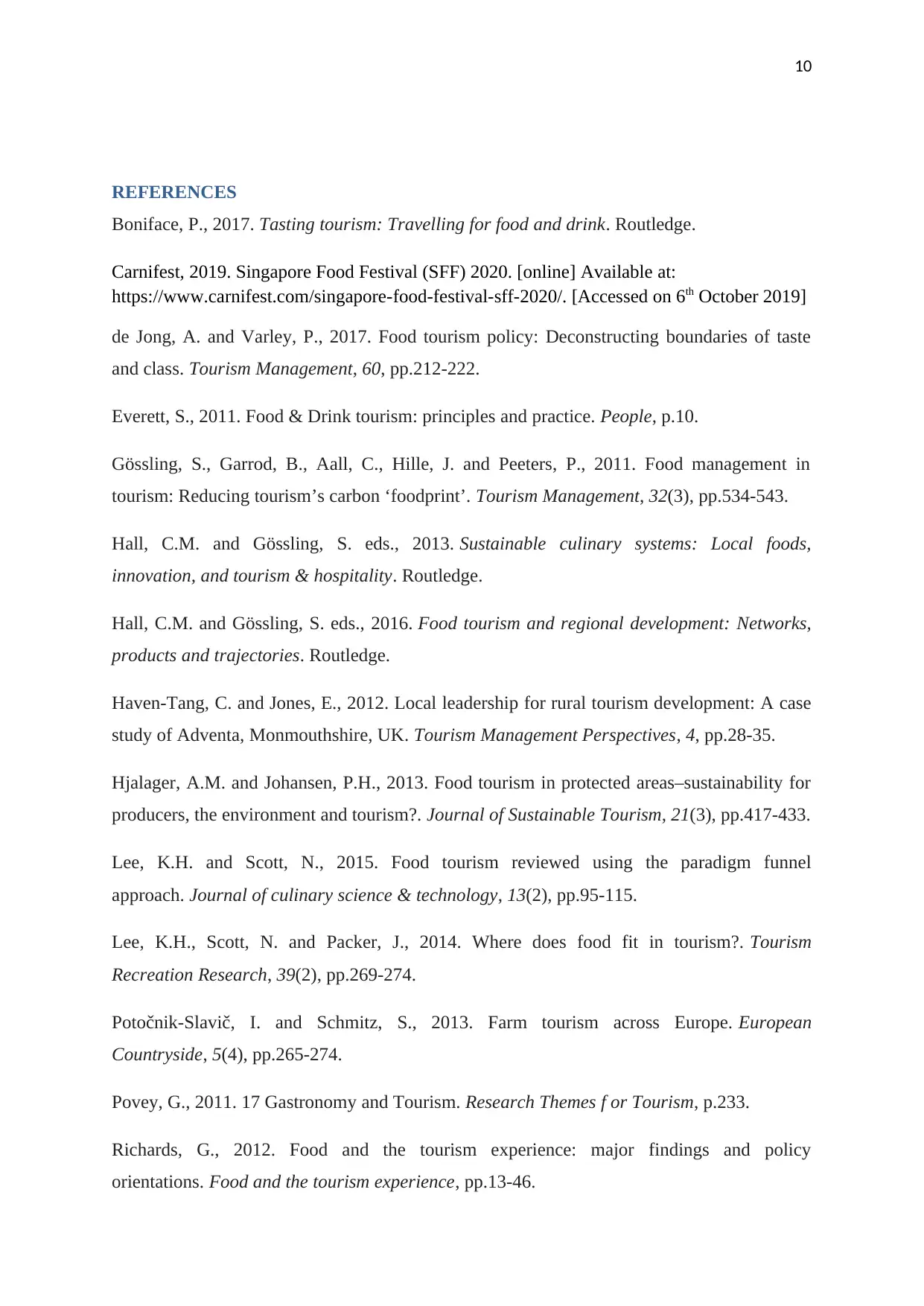
10
REFERENCES
Boniface, P., 2017. Tasting tourism: Travelling for food and drink. Routledge.
Carnifest, 2019. Singapore Food Festival (SFF) 2020. [online] Available at:
https://www.carnifest.com/singapore-food-festival-sff-2020/. [Accessed on 6th October 2019]
de Jong, A. and Varley, P., 2017. Food tourism policy: Deconstructing boundaries of taste
and class. Tourism Management, 60, pp.212-222.
Everett, S., 2011. Food & Drink tourism: principles and practice. People, p.10.
Gössling, S., Garrod, B., Aall, C., Hille, J. and Peeters, P., 2011. Food management in
tourism: Reducing tourism’s carbon ‘foodprint’. Tourism Management, 32(3), pp.534-543.
Hall, C.M. and Gössling, S. eds., 2013. Sustainable culinary systems: Local foods,
innovation, and tourism & hospitality. Routledge.
Hall, C.M. and Gössling, S. eds., 2016. Food tourism and regional development: Networks,
products and trajectories. Routledge.
Haven‐Tang, C. and Jones, E., 2012. Local leadership for rural tourism development: A case
study of Adventa, Monmouthshire, UK. Tourism Management Perspectives, 4, pp.28-35.
Hjalager, A.M. and Johansen, P.H., 2013. Food tourism in protected areas–sustainability for
producers, the environment and tourism?. Journal of Sustainable Tourism, 21(3), pp.417-433.
Lee, K.H. and Scott, N., 2015. Food tourism reviewed using the paradigm funnel
approach. Journal of culinary science & technology, 13(2), pp.95-115.
Lee, K.H., Scott, N. and Packer, J., 2014. Where does food fit in tourism?. Tourism
Recreation Research, 39(2), pp.269-274.
Potočnik-Slavič, I. and Schmitz, S., 2013. Farm tourism across Europe. European
Countryside, 5(4), pp.265-274.
Povey, G., 2011. 17 Gastronomy and Tourism. Research Themes f or Tourism, p.233.
Richards, G., 2012. Food and the tourism experience: major findings and policy
orientations. Food and the tourism experience, pp.13-46.
REFERENCES
Boniface, P., 2017. Tasting tourism: Travelling for food and drink. Routledge.
Carnifest, 2019. Singapore Food Festival (SFF) 2020. [online] Available at:
https://www.carnifest.com/singapore-food-festival-sff-2020/. [Accessed on 6th October 2019]
de Jong, A. and Varley, P., 2017. Food tourism policy: Deconstructing boundaries of taste
and class. Tourism Management, 60, pp.212-222.
Everett, S., 2011. Food & Drink tourism: principles and practice. People, p.10.
Gössling, S., Garrod, B., Aall, C., Hille, J. and Peeters, P., 2011. Food management in
tourism: Reducing tourism’s carbon ‘foodprint’. Tourism Management, 32(3), pp.534-543.
Hall, C.M. and Gössling, S. eds., 2013. Sustainable culinary systems: Local foods,
innovation, and tourism & hospitality. Routledge.
Hall, C.M. and Gössling, S. eds., 2016. Food tourism and regional development: Networks,
products and trajectories. Routledge.
Haven‐Tang, C. and Jones, E., 2012. Local leadership for rural tourism development: A case
study of Adventa, Monmouthshire, UK. Tourism Management Perspectives, 4, pp.28-35.
Hjalager, A.M. and Johansen, P.H., 2013. Food tourism in protected areas–sustainability for
producers, the environment and tourism?. Journal of Sustainable Tourism, 21(3), pp.417-433.
Lee, K.H. and Scott, N., 2015. Food tourism reviewed using the paradigm funnel
approach. Journal of culinary science & technology, 13(2), pp.95-115.
Lee, K.H., Scott, N. and Packer, J., 2014. Where does food fit in tourism?. Tourism
Recreation Research, 39(2), pp.269-274.
Potočnik-Slavič, I. and Schmitz, S., 2013. Farm tourism across Europe. European
Countryside, 5(4), pp.265-274.
Povey, G., 2011. 17 Gastronomy and Tourism. Research Themes f or Tourism, p.233.
Richards, G., 2012. Food and the tourism experience: major findings and policy
orientations. Food and the tourism experience, pp.13-46.
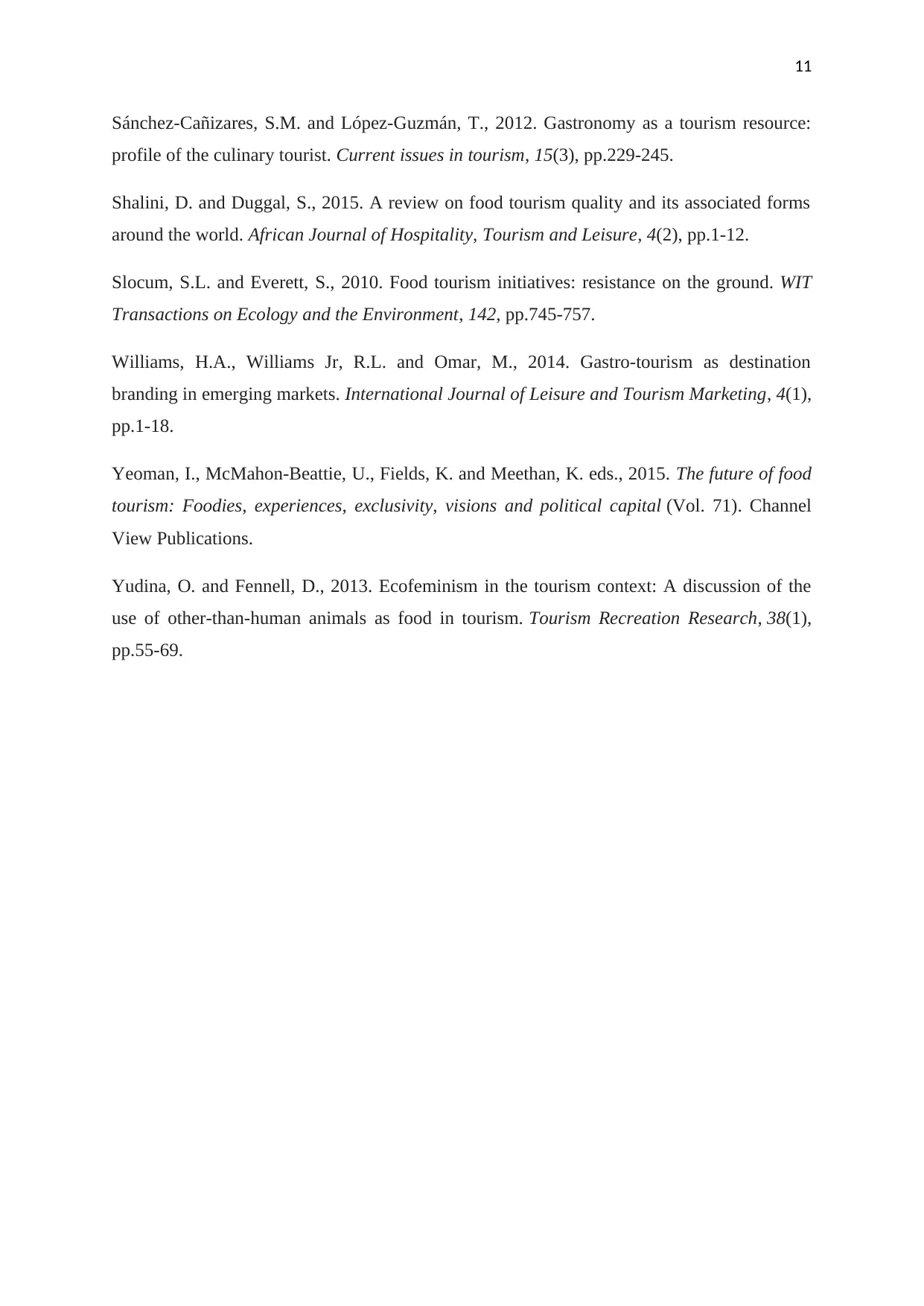
11
Sánchez-Cañizares, S.M. and López-Guzmán, T., 2012. Gastronomy as a tourism resource:
profile of the culinary tourist. Current issues in tourism, 15(3), pp.229-245.
Shalini, D. and Duggal, S., 2015. A review on food tourism quality and its associated forms
around the world. African Journal of Hospitality, Tourism and Leisure, 4(2), pp.1-12.
Slocum, S.L. and Everett, S., 2010. Food tourism initiatives: resistance on the ground. WIT
Transactions on Ecology and the Environment, 142, pp.745-757.
Williams, H.A., Williams Jr, R.L. and Omar, M., 2014. Gastro-tourism as destination
branding in emerging markets. International Journal of Leisure and Tourism Marketing, 4(1),
pp.1-18.
Yeoman, I., McMahon-Beattie, U., Fields, K. and Meethan, K. eds., 2015. The future of food
tourism: Foodies, experiences, exclusivity, visions and political capital (Vol. 71). Channel
View Publications.
Yudina, O. and Fennell, D., 2013. Ecofeminism in the tourism context: A discussion of the
use of other-than-human animals as food in tourism. Tourism Recreation Research, 38(1),
pp.55-69.
Sánchez-Cañizares, S.M. and López-Guzmán, T., 2012. Gastronomy as a tourism resource:
profile of the culinary tourist. Current issues in tourism, 15(3), pp.229-245.
Shalini, D. and Duggal, S., 2015. A review on food tourism quality and its associated forms
around the world. African Journal of Hospitality, Tourism and Leisure, 4(2), pp.1-12.
Slocum, S.L. and Everett, S., 2010. Food tourism initiatives: resistance on the ground. WIT
Transactions on Ecology and the Environment, 142, pp.745-757.
Williams, H.A., Williams Jr, R.L. and Omar, M., 2014. Gastro-tourism as destination
branding in emerging markets. International Journal of Leisure and Tourism Marketing, 4(1),
pp.1-18.
Yeoman, I., McMahon-Beattie, U., Fields, K. and Meethan, K. eds., 2015. The future of food
tourism: Foodies, experiences, exclusivity, visions and political capital (Vol. 71). Channel
View Publications.
Yudina, O. and Fennell, D., 2013. Ecofeminism in the tourism context: A discussion of the
use of other-than-human animals as food in tourism. Tourism Recreation Research, 38(1),
pp.55-69.
⊘ This is a preview!⊘
Do you want full access?
Subscribe today to unlock all pages.

Trusted by 1+ million students worldwide
1 out of 12
Related Documents
Your All-in-One AI-Powered Toolkit for Academic Success.
+13062052269
info@desklib.com
Available 24*7 on WhatsApp / Email
![[object Object]](/_next/static/media/star-bottom.7253800d.svg)
Unlock your academic potential
Copyright © 2020–2025 A2Z Services. All Rights Reserved. Developed and managed by ZUCOL.





